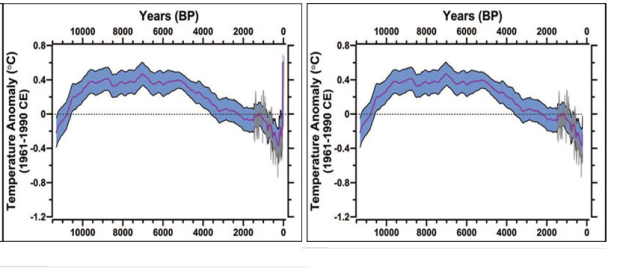Tuesday, April 02, 2013
Marcott Mark-Up
Here are two versions of the recent Marcott, et al. global average temperature reconstruction graph:
The one on the left has a huge temperature spike in the last 100 years or so; the one on the right is more accurate. How can I say that? Read it and weep, alarmists!
The reconstruction on the right generally looks like a famous Greenland ice core reconstruction below:
Sure sounds like the fraudulent 20th Century spike was certainly the basis for their conclusion, despite their Easter Sunday admission.
Hinderaker also is waiting in vain for the myriad media outlets to correct the false impression their coverage of the fraud has left on the public.
Days go by and still I think of you...
The one on the left has a huge temperature spike in the last 100 years or so; the one on the right is more accurate. How can I say that? Read it and weep, alarmists!
The reconstruction on the right generally looks like a famous Greenland ice core reconstruction below:
Except for three things: 1) The length of the interglacial that the graph purports to represent is about 3000 years longer on Marcott's graph; 2) There is very little detail of the warm and cold periods on Marcott's graph; and, 3) The difference in high and low temperatures in Greenland were up to 4 degrees C, while on Marcott's graph that difference is about 10 times less.
The last two anomalies are explained by Mr. McKitrick in his article linked to above, but the greater than 25% difference in the length of the interglacial is not explained.
So the key and remarkable difference between the Marcott reconstruction and all the earlier ones was the huge temperature spike at the end, that is, in the 20th Century. That spike is what got everyone's attention. That's what all the fuss was about. The authors of the study specifically mentioned it in the abstract for the article: "Temperatures have risen steadily since [the Little Ice Age], leaving us now with a global temperature higher than those during 90% of the entire Holocene." So it is all the more surprising that Marcott, et al. would so quickly and decisively admit the 20th Century temperature spike is bogus, as they did, in scientificese, here:
Our global paleotemperature reconstruction includes a so-called “uptick” in temperatures during the 20th-century. However, in the paper we make the point that this particular feature is of shorter duration than the inherent smoothing in our statistical averaging procedure, and that it is based on only a few available paleo-reconstructions of the type we used. Thus, the 20th century portion of our paleotemperature stack is not statistically robust, cannot be considered representative of global temperature changes, and therefore is not the basis of any of our conclusions. (Emphasis added).
In my book, a retraction by Science, where the paper was published, is in order and corrections of all the praising coverage, including the NYT's love fest, should immediately be published.
Don't hold your breath.
The global warming alarmists are seriously damaging the once sterling reputation of science itself.
UPDATE: John Hinderaker comes to almost the same conclusion here. His take is that this was clear fraud which was detected and the fraudsters recanted. That sounds right. He points out Marcott said this before the fraud was detected:
What we’ve found is that temperatures increased in the last hundred years as much as they had cooled in the lst six or seven thousand. In other words, the rate of change is much greater than anything we’ve seen in the whole Holocene.
Sure sounds like the fraudulent 20th Century spike was certainly the basis for their conclusion, despite their Easter Sunday admission.
Hinderaker also is waiting in vain for the myriad media outlets to correct the false impression their coverage of the fraud has left on the public.
Days go by and still I think of you...
Labels: Bogus New Reconstruction; Marcott. McKitrick




